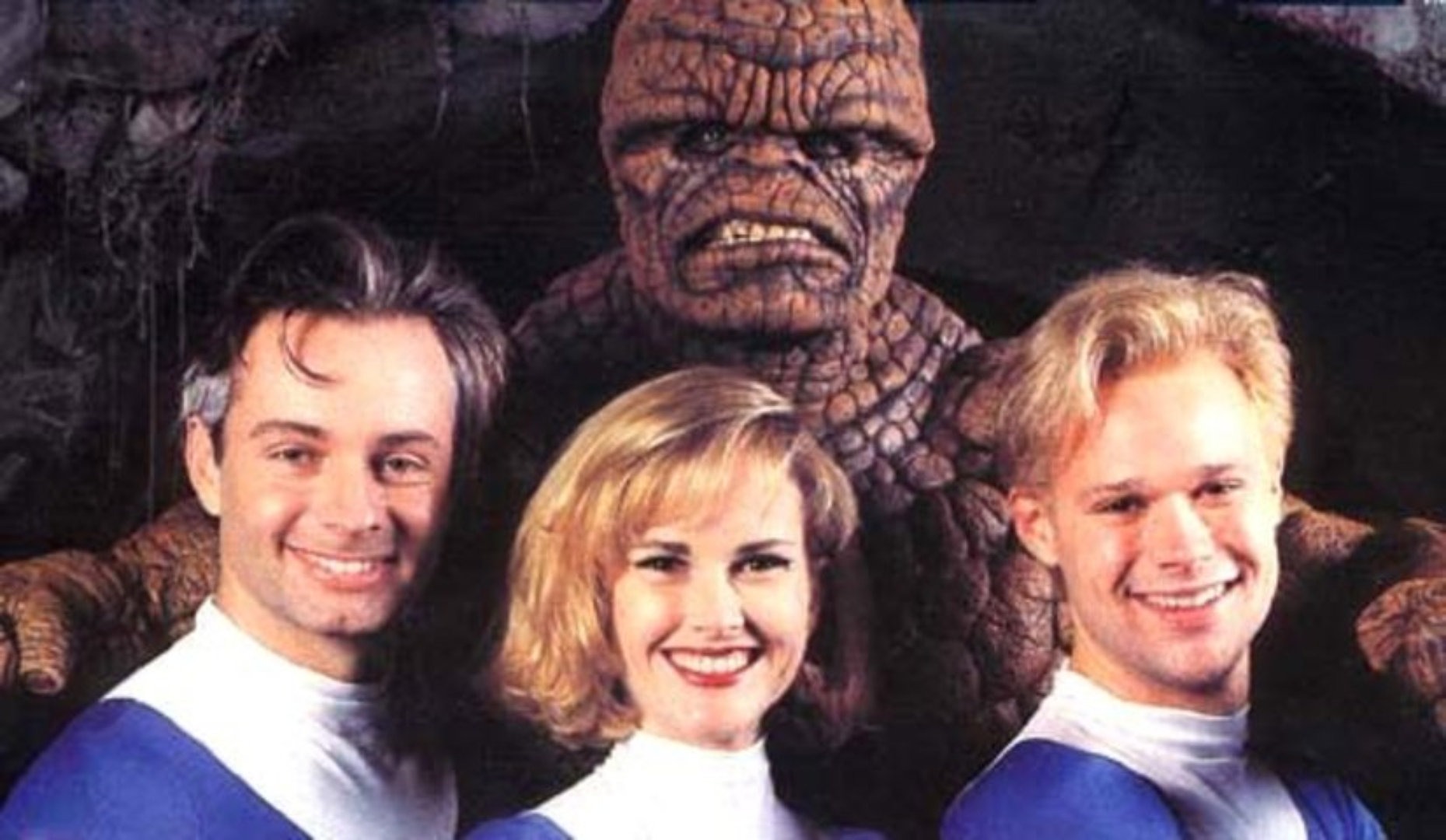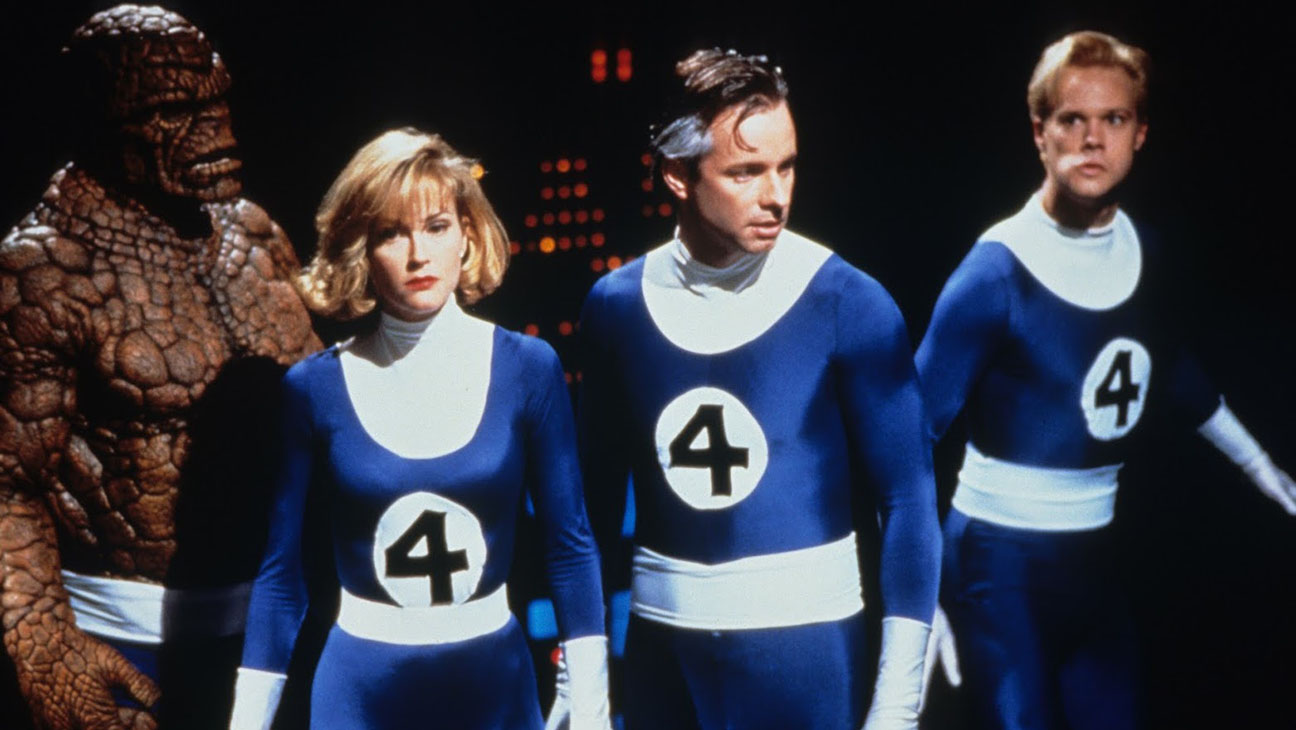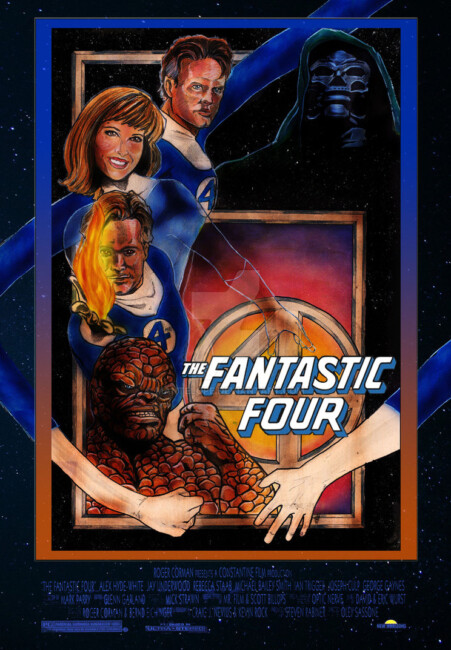USA/Germany. 1994.
Crew
Director – Oley Sassone, Screenplay – Craig J. Nevius & Kevin Rock, Based on the Comic Book Created by Jack Kirby & Stan Lee, Producer – Steven Rabiner, Photography – Mark Parry, Music – David Wurst & Eric Wurst, Special Effects – Billups Communications Inc. & Mr. Film (Animation Director – Chris Walker), Miniatures – Brad Johnson & Mick Strawn, Makeup Effects – Optic Nerve, Production Design – Mick Strawn. Production Company – New Horizons/Constantin Film.
Cast
Alex Hyde-White (Reed Richards), Jay Underwood (Johnny Storm), Rebecca Staab (Susan Storm), Carl Ciarfalio (The Thing), Michael Bailey Smith (Ben Grimm), Joseph Culp (Dr Doom/Victor Von Doom), Ian Trigger (The Jeweler), Kat Green (Alicia Masters), Howard Shangraw (Krogstadt), David Keith Miller (Trigorin), Robert Beuth (Hauptman), George Gaynes (Professor)
Plot
As university students, the brilliant Reed Richards and his best friend Victor Von Doom create a device to harness the energies of the passing comet Colossus. However, the experiment goes wrong and Victor gets a full dose of the comet’s rays and is killed. Ten years later, Reed has created a space mission to go into orbit and tap the rays of Colossus. He asks his good friend Ben Grimm to act as pilot, while their friends, brother and sister Johnny and Susan Storm, sign on as crew. Just before the mission launches, The Jeweler, a criminal mastermind who runs a lair for rejects on the streets, breaks in and steals the giant diamond that Reed is going to use to harness the rays of the comet and substitutes a fake duplicate. The Jeweler wants the diamond as wedding gift for his intended ‘wife’ – the blind girl Alicia Masters that Ben has taken a liking to – and orders her abducted. The mission launches but without the diamond the group suffer exposure to the comet’s rays and the shuttle crashes. They survive to find that they now have strange powers – Reed can stretch his body like elastic, Johnny can become a human flame, Susan can become invisible, while Ben develops a thick, rock-like orange skin. They are captured by Dr Doom, a sinister ruler of a foreign country who hides behind a metal mask, but make an escape. Doom, who in reality is Reed’s old friend Victor, comes seeking the diamond from The Jeweler to create a massive laser that he plans to turn on New York City.
The Fantastic Four is one of the most popular comic-books from Marvel Comics. The Fantastic Four first appeared in their self-titled comic-book in 1961, created by Marvel mastermind Stan Lee and the legendary Jack Kirby. The intent at the time was to create a superhero team that could compete with the success enjoyed by rival company DC’s Justice League of America, which had appeared one year before to great success. It was also the first comic-book on which Stan Lee tried out what became known as The Marvel Method involving fallible superheroes dealing with real world problems. The Fantastic Four rapidly became one of Marvel’s most popular titles and served to introduce a number of other popular Marvel characters including Sub-Mariner, Ant Man, Black Panther and especially the Silver Surfer. The Fantastic Four have appeared in other media, including four different animated series, Hanna-Barbera’s Fantastic Four (1967), The Fantastic Four (1978), Fantastic Four (1994-6) and Fantastic Four: World’s Greatest Heroes (2006-7). Of course, the incarnation most familiar to people is the two movie versions made during the big surge of Marvel Comics adapted films in the 00s with Fantastic Four (2005), Fantastic Four: Rise of the Silver Surfer (2007) and the subsequent reboot Fantastic Four (2015).
The Fantastic Four (the film version here) has a legendary reputation, especially in that the world at large has never seen the film. It has never received any cinematic or video/dvd release – in fact, it has never been released in any form officially and the only copies available are bootleg ones that have been uploaded to various download sites.
The Fantastic Four came about not long after the Tim Burton Batman (1989). The massive success of Batman saw a number of other comic-book properties making their way onto film during the early 1990s. Germany’s Constantin Film production company had obtained an option on the rights to The Fantastic Four but these were about to lapse. Around this time, others were vying for the rights to The Fantastic Four, notably Chris Columbus who executive produced and was originally intending to direct the 2005 version. Constantin realised that if they quickly made a version of The Fantastic Four instead of letting the option lapse then Columbus and co would be forced to pay to obtain the rights off them. And so they turned to legendary producer-director Roger Corman, notorious for his low-budget films.

Thus The Fantastic Four was churned out by Corman’s New Horizons production company with minimal effort accorded it and the intention of it never being released to theatres. The cast were convinced to defer upfront fees, led to believe the possibility it would be spun out as a tv series. Roger Corman gave the film no more than a $2 million budget, which is barely even the star’s salary on most A-list films. The result was shelved and Constantin made a packet on-selling the rights to 20th Century Fox and laughing all the way to the bank. It must be said that very different stories abound as to what happened – Constantin head Bernd Eichinger claims that it was Marvel Enterprises head Avi Arad who offered him money to not release the film, which is a little hard to believe given that Marvel had no problems with the release of the dire version of Captain America (1990) a couple of years earlier.
Whatever the case, The Fantastic Four film has garnered a legendarily awful reputation – mostly it appears from people who only know of the circumstances of its making. Seen, the film sits there and consistently defies any such reputation. Indeed, considering the parsimoniousness and cynicism of the circumstances under which it was made, The Fantastic Four emerges as far better than anything one might expect. In fact, the production finish on the film is an argument against its not ever intending to be released – it is one thing to make a film that is not for release but to actually go into post-production on it is another story altogether.
The script is surprisingly faithful to the Marvel comic-book – even more so than the 2005 version in many regards. The writers have clearly done their homework and are fans of the comic-books. There are all the familiar touches – the Baxter Building, the blue suits, Reed with his grey sideburns, Ben’s love interest of the blind Alicia Masters, lines like “It’s clobberin’ time” and “Flame on”. The Four’s origin story of being irradiated aboard a space mission is depicted far closer to the comic-book than the way it was in the 2005 film. This Dr Doom is also far nearer to his original conception – seeing him in his cape and metal-masked costume and ruling over Latveria, Doom could have almost stepped right off the comic-book page. Alex Hyde-White’s performance as Reed Richards is exactly the way one imagines him to be in the comic-book, even more than Ioan Gruffud’s incarnation. Ben’s makeup as The Thing looks reasonably convincing and Carl Ciarfalio and Michael Bailey Smith play the part, capturing perfectly the gruff temperament that Ben has on the page.

The one character that does not work is Jay Underwood’s Johnny where Underwood looks for all the world like Kirk Cameron has been cast in the role and simply emerges as too boyish. The other poor aspect is the villain The Jeweler, a character that does not appear in the comic-books but is original to the film. Ian Trigger’s performance is annoyingly over-the-top – The Jeweler scenes feel like they have strayed in from a tattily budgeted children’s film, all madly overplayed cackling and with a jaunty carnival score, while the costuming makes the character look more like Warwick Davis in Leprechaun (1993) and sequels than a super-villain.
The cheapness of the production undeniably shows through. During the space mission, we only get a single exterior shot of the shuttle. All that we see of the meteor is cheap coloured light effects, while Dr Doom’s Latverian castle is represented by a single matte painting. There is even stock NASA footage employed for the shuttle launch and tv disaster footage to stand in for the effects of the laser. Directorially, Oley Sassone’s handling is unexceptional – the film has been shot in the Ultra-Stereo video process and the direction and lighting are plain and unadorned making the film looks like no more than filler tv or another of Roger Corman’s B-budget action films.
Perhaps the biggest disappointment is that the lack of budget fails to give the film enough room to open up and show the Fantastic Four in action as superheroes. The film is not unlike tv’s Adventures of Superman (1952-8), The Amazing Spiderman (1977-9) or The Incredible Hulk (1977-81) where the production team could only produce economy superheroics and there were never such things as super-villains, merely the superheroes going into action against routine villains and thugs because there was no effects budget for anything bigger in scale. There are disappointing corners cut here – Susan’s invisibility is the easiest to get away with, no more than some double-exposures and a disembodied voice; for Johnny as The Human Torch, we get merely animated optical overlays; while Reed’s stretching is limited to only seeing part of a leg or an arm very occasionally stretched across a room but with something always preventing it from being shown in the same shot as Alex Hyde-White.
Things finally start to get properly superheroic at the 57-minute mark where we get a minor flourish of powers during the escape from Dr Doom’s castle with Ben punching out guards, Johnny manifesting a clearly animated thermic lance to burn through the walls, while Reed extends a leg to trip guards up and Susan turns invisible to trip and knock people out. It is tattily low-horizoned but at least it’s the Fantastic Four in action. And the film does get everything together for a modestly effective climactic battle involving Reed stretching his arms to punch people and rescue Dr Doom who has fallen halfway down the wall of the castle, Susan projecting a forcefield, and in particular Johnny finally becoming the Human Torch we all know and racing through the skies to deflect the path of the laser beam. It is here that The Fantastic Four finally does achieve something of suitably superheroic scale.
The story behind The Fantastic Four is told in the documentary Doomed: The Untold Story of Roger Corman’s The Fantastic Four (2015).
Full film available online here:-


